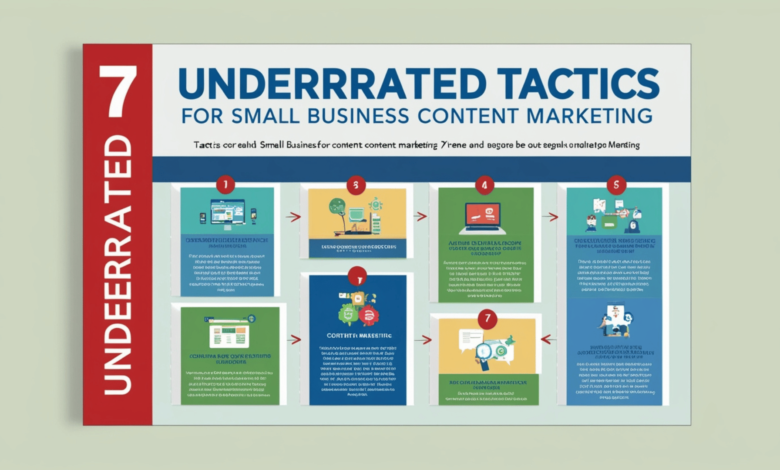
Content marketing has been the cornerstone for businesses to thrive in the digital world. Yet, for small businesses, it is often challenging to compete against larger competitors with massive marketing budgets. The key to standing out is leveraging small business content marketing strategies that not only drive engagement but also are often overlooked. In this detailed guide, we will reveal 7 underrated tactics, supported by expert insights from underrated marketing opinion blogs that can significantly elevate your content marketing game.
Why Small Business Content Marketing Matters
Every small business wants to get noticed, but achieving that visibility without a comprehensive content marketing strategy is tough. The digital landscape is filled with competition, but small business content marketing can level the playing field by:
- Building brand authority with informative and valuable content.
- Creating organic SEO opportunities to rank better on search engines.
- Engaging with your target audience effectively.
- Generating qualified leads who are already interested in what your business offers.
Even more, when integrated with insights from underrated marketing opinion blogs, small businesses can craft strategies that push boundaries and avoid the same old marketing tactics.
Step-by-Step Small Business Content Marketing Strategy
Here’s a deep dive into the most effective yet underused techniques for small business content marketing:
1. Prioritize Long-Tail Keywords for SEO Success
Keyword research is the foundation of any successful content marketing strategy, and the use of long-tail keywords plays a pivotal role in the success of small business content marketing. Long-tail keywords such as “small business content marketing tactics” or “underrated marketing opinion blogs” provide more precise results and are less competitive than broad terms.
- Use tools like Google Keyword Planner or SEMrush to identify relevant long-tail keywords.
- Make sure to integrate these keywords organically into your content, ensuring your primary keyword (small business content marketing) appears in about 1-2% of the text.
2. Create Niche Content for Your Specific Audience
Creating content that resonates with your specific audience is essential. But what many small businesses overlook is niche content. Content that speaks directly to your customers’ unique needs increases engagement and trust.
Consider writing blog posts, guides, or eBooks tailored to specific customer pain points. For example, a local retail shop might focus on “content marketing for small local businesses,” while a B2B company could cover “content marketing for small SaaS startups.”
By narrowing your focus, you’ll be able to create more relevant and actionable content that stands out in a crowded marketplace.
3. Leverage User-Generated Content and Customer Stories
One of the most underrated marketing opinions is the power of user-generated content (UGC). UGC, such as reviews, testimonials, or social media posts from customers, provides credibility and authentic social proof that potential customers trust.
- Encourage customers to share their stories and experiences.
- Repurpose their reviews into case studies or testimonials on your website.
UGC not only enhances your brand’s trustworthiness but also reduces the burden of creating new content while improving your small business content marketing efforts.
4. Consistent Blogging Backed by Underrated Opinion Blogs
Blogging consistently is one of the oldest tricks in the content marketing playbook, yet many small businesses fail to recognize the ongoing importance of this tactic. Regularly updating your blog with fresh, relevant content drives SEO rankings, but more importantly, underrated marketing opinion blogs suggest going beyond just blogging for SEO.
- Use blog posts to share industry opinions, tips, and advice that your audience finds valuable.
- Draw inspiration from expert blogs and combine that with personal insights to offer a fresh take on topics.
For example, publishing thought-leadership articles on underrated marketing practices can significantly drive traffic and establish authority within your niche.
Check Also: Top 7 Proven Best Marketing Strategy for Business Success in 2024
5. Interactive and Visual Content: An Overlooked Goldmine
Today’s readers crave engaging and interactive content. This goes beyond simple blog posts and into visual elements like videos, infographics, and interactive quizzes. Incorporating interactive elements in your small business content marketing efforts can drastically improve user engagement and dwell time.
- Create engaging infographics summarizing the key takeaways of your articles.
- Include interactive elements like polls, quizzes, or assessments to boost user interaction.
- Embed informative videos explaining a concept or showcasing your product/service.
6. Optimize Content for Voice Search
Voice search is rapidly growing, especially with devices like Amazon Alexa and Google Home becoming household staples. Optimizing your small business content marketing for voice search allows you to tap into a new audience segment.
How can you optimize for voice search?
- Focus on conversational language and question-based queries.
- Implement FAQ sections that answer common questions your audience might ask.
- Ensure your website is mobile-friendly and loads quickly, as voice search often pulls answers from mobile-optimized content.
7. Repurpose and Promote Across Multiple Channels
A mistake many small businesses make is publishing content once and then leaving it. The key to effective small business content marketing is repurposing your content and promoting it across multiple channels.
- Turn a blog post into a video: Repurpose long-form blog posts into short YouTube videos.
- Repurpose content into social media snippets: Break down blog posts into digestible pieces and share them across social platforms.
- Convert blog content into email newsletters: Send a weekly or monthly digest of your blog posts to subscribers.
By promoting across various channels, you extend the life of your content, driving traffic back to your website from diverse sources.
Measuring Your Content Marketing ROI
No content marketing effort is complete without measuring its impact. Monitoring key metrics will give you insights into what’s working and what isn’t. Focus on these critical metrics:
- Organic Traffic: Track your website traffic coming from organic search. Use tools like Google Analytics to monitor the performance of each page.
- Engagement: Measure user engagement through social shares, comments, and time on page.
- Conversion Rates: Evaluate how many leads or sales are generated through your content.
Lastly, ensure that you optimize your strategy based on the data you collect. Replicate what works and refine what doesn’t to improve your overall results.
Conclusion
Small business content marketing can be the driving force behind your brand’s growth when done right. By leveraging underrated tactics and drawing insights from underrated marketing opinion blogs, you’ll be better positioned to stand out in a competitive market. Prioritize long-tail keywords, create niche content, use user-generated content, optimize for voice search, and don’t forget to measure and adjust your strategy.
With a well-executed plan, your small business can unlock the full potential of content marketing and experience sustainable growth in the digital age.



